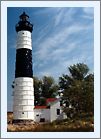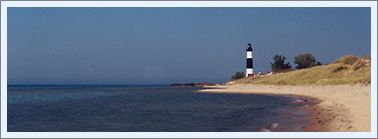|
Historical
Information

In its' report to Congress in 1865, the
Lighthouse Board presented the case that "the interests of commerce
demand that Grand Point Au Sable be suitably lighted" Congress
responded favorably on July of the following year with an appropriation
of $35,000 on July 28 of the following year. The State of Michigan
responded by providing the Federal Government with fee deed to nine
hundred and thirty-three acres for the station later that year.
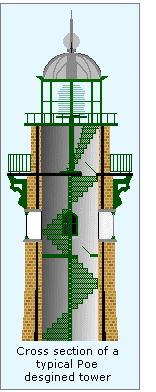 Construction began in early 1867 with
the arrival of Lighthouse Board and Army Corps of Engineers workers, who
immediately began the construction of a dock at which to unload the
necessary supplies for the project. Next, a temporary cofferdam was
constructed to keep waster from entering the foundation, which consisted
of tightly fitted cut stone blocks beginning a depth of six feet below
grade and extending three feet above. Construction began in early 1867 with
the arrival of Lighthouse Board and Army Corps of Engineers workers, who
immediately began the construction of a dock at which to unload the
necessary supplies for the project. Next, a temporary cofferdam was
constructed to keep waster from entering the foundation, which consisted
of tightly fitted cut stone blocks beginning a depth of six feet below
grade and extending three feet above.
On this sturdy foundation, the skilled
masons began to raise the tower. Constructed of cream city
brick, the
walls were laid five feet thick at the foundation, tapering to a
thickness of two feet thick immediately below the gallery. Within the
tower, a circular inner wall, eight feet in diameter supported the cast
iron spiral staircase. On its' vertical climb, the stairway passed
through three landing areas.
The lowest was known as the Service
Room, and consisted of an enlarged landing area containing a built-in
cabinet for the storage of wicks, lamp chimneys and other supplies. The second area was known as the Watch
Room, and consisted of a full floor and ceiling with closable trap doors
to the stairs above and below. The trap doors served a vital role in
eliminating the "chimney effect" that exists in such tall
structures. Without an air lock of some type, air rises rapidly through
such structures, and a strong updraft would cause havoc with the
all-important flame in the lantern room. By ensuring that one of these
two doors was closed at all times, the chimney effect was eliminated.
Keepers spent many hours on the watch room
gallery, which circled the outside of the watch room, keeping vigil over
the shores.
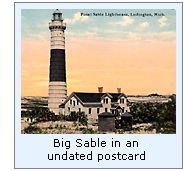 Finally, the trap door in the ceiling
led to the lantern, where the fixed white Third Order Fresnel lens
was displayed. The lantern room itself was a decagonal cast iron
structure, and featured a small door below the windows through which
keepers would crawl to clean the windows from the small gallery that
encircled the base of the lantern room. This lantern room gallery was
significantly narrower than that encircling the watch room, and to
increase the margin for safety, the astragals of the lantern room were
fitted with hand-holds, which the keeper's could hold or tie onto while
cleaning the windows. Finally, the trap door in the ceiling
led to the lantern, where the fixed white Third Order Fresnel lens
was displayed. The lantern room itself was a decagonal cast iron
structure, and featured a small door below the windows through which
keepers would crawl to clean the windows from the small gallery that
encircled the base of the lantern room. This lantern room gallery was
significantly narrower than that encircling the watch room, and to
increase the margin for safety, the astragals of the lantern room were
fitted with hand-holds, which the keeper's could hold or tie onto while
cleaning the windows.
Standing one hundred and twelve feet
from grade to the top of the ventilator ball, construction of the tower
was complete, and the masons turned their attention to the keepers
dwelling.
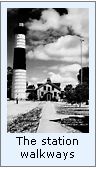 Cream city brick was also used in the
construction of the story-and-a-half dwelling with full basement.
Designed as a duplex, the head keepers quarters took up the entire first
floor and consisted of an oil storage room, kitchen, living room and a
single bedroom. The Assistant Keeper's quarters on the second floor were
made up of two bedrooms, a kitchen and living room. The roof gutters fed
into an underground cistern for the collection and storage of water.
Outfitted with two-way valves, the downspouts could be directed to
discharge either onto the ground or into the cistern. Thus, prior to
diverting water into the cistern, the keepers would allow the water to
run to the ground to ensure that all debris was washed from the roof,
before allowing the water to flow into the cistern. Cream city brick was also used in the
construction of the story-and-a-half dwelling with full basement.
Designed as a duplex, the head keepers quarters took up the entire first
floor and consisted of an oil storage room, kitchen, living room and a
single bedroom. The Assistant Keeper's quarters on the second floor were
made up of two bedrooms, a kitchen and living room. The roof gutters fed
into an underground cistern for the collection and storage of water.
Outfitted with two-way valves, the downspouts could be directed to
discharge either onto the ground or into the cistern. Thus, prior to
diverting water into the cistern, the keepers would allow the water to
run to the ground to ensure that all debris was washed from the roof,
before allowing the water to flow into the cistern.
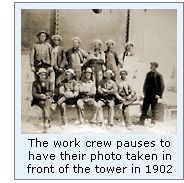 In 1898, the District Inspector
reported that the cream city brick used in constructing the tower was
found to be flaking as a result of exposure to the elements, and voiced
concern that if left as-is, the integrity of the tower would likely be
compromised. This flaking grew so severe, that in 1899 a contract was
awarded to the J. G. Wagner Company of Milwaukee to construct the
necessary steel plates to encase the tower. The plates were
satisfactorily test assembled at the Milwaukee Lighthouse Depot, loaded
onto lighthouse tenders and then shipped to Big Sable. With the arrival
of the plates, the process of riveting the plates together around the
tower, and filling the void between the brick and the plates with cement
began. The construction was completed in June 1900 at a total labor and
materials cost of $4,925. In order to increase the visibility of the
tower during daylight hours, the new cladding was painted white with a
contrasting black band around its' middle third. In 1898, the District Inspector
reported that the cream city brick used in constructing the tower was
found to be flaking as a result of exposure to the elements, and voiced
concern that if left as-is, the integrity of the tower would likely be
compromised. This flaking grew so severe, that in 1899 a contract was
awarded to the J. G. Wagner Company of Milwaukee to construct the
necessary steel plates to encase the tower. The plates were
satisfactorily test assembled at the Milwaukee Lighthouse Depot, loaded
onto lighthouse tenders and then shipped to Big Sable. With the arrival
of the plates, the process of riveting the plates together around the
tower, and filling the void between the brick and the plates with cement
began. The construction was completed in June 1900 at a total labor and
materials cost of $4,925. In order to increase the visibility of the
tower during daylight hours, the new cladding was painted white with a
contrasting black band around its' middle third.
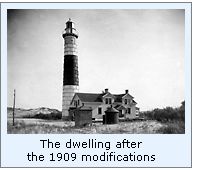 On July 12, 1909, after the
installation of a fog signal to the station's inventory, a Second
Assistant was authorized at the station. Rather than building a second
dwelling to accommodate the additional keeper and his family, the
decision was made to undertake a complete remodeling of the existing
dwelling. With the completion of this project, the station appeared much
as it does to this day. On July 12, 1909, after the
installation of a fog signal to the station's inventory, a Second
Assistant was authorized at the station. Rather than building a second
dwelling to accommodate the additional keeper and his family, the
decision was made to undertake a complete remodeling of the existing
dwelling. With the completion of this project, the station appeared much
as it does to this day.
Access improved significantly when a
road was built to the station in 1933. To stem increasing erosion, the
Coast Guard installed a seawall around the tower in 1943.
Big Sable holds the distinction of
being the last Great Lakes light to become electrified in 1949. However,
electrification was always a double-edged-sword, in that it paved the
way for automation, and the eventual elimination of the need for a
keeper in 1968.
Unmanned and virtually abandoned, and
well out of the eyes of public scrutiny, the buildings deteriorated
rapidly due vandalism and lack of maintenance. The 1943 seawall was
breached in 1977, and waves came perilously close to undermining the
tower before the seawall could be replaced.
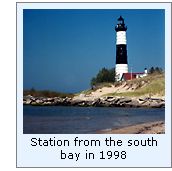 After receiving listing number 83004296
in the National Register of Historic Places on August 4, 1983, the
Foundation for Behavioral Research was granted a 25-year lease on the
station in 1986. The Big Sable Point Lighthouse Keepers Association
formed in 1987, and in concert the two organizations have worked to
restore the station to its original glory. After receiving listing number 83004296
in the National Register of Historic Places on August 4, 1983, the
Foundation for Behavioral Research was granted a 25-year lease on the
station in 1986. The Big Sable Point Lighthouse Keepers Association
formed in 1987, and in concert the two organizations have worked to
restore the station to its original glory.
While no longer equipped with it's
Fresnel lens, Big Sable's 300mm plastic optic still shines proudly
across the shore of Lake Michigan, a beacon to mariners, a link to
Michigan's proud maritime heritage, and a memorial to the proud keepers
who worked so hard to keep the light burning throughout the years.

Keepers of
this Light

Click
Here to see a complete listing of all Big Sable Pont Light
keepers compiled by Phyllis L. Tag of Great Lakes Lighthouse Research.

Seeing this
Light

Take US 10 West into Ludington, and head west toward the Lake. Turn
right onto Lakeshore Drive (also known as M116), and head North
approximately 6 1/2 miles to the entrance of Ludington State Park. When
registering at the Park, ask for information on the lighthouse, and you
will receive a single page hand-out which includes a map of the park.
The mile-long trail to the lighthouse begins at a yellow gate located on
the West side of the campground.

Contact information

Big Sable Lighthouse Keepers Association website.
PO Box 673
Ludington, MI 49431

Reference
Sources

Inventory of Historic Light Stations, National Parks Service, 1994.
Big Sable Point Light Station, Thomas A. Tag, 1997
Photographs from author's personal collection.
Personal observation at Big Sable, 09/13/1998
Historic images from the US Coast Guard, Michigan State Archives, &
National Archives.
USCG Historians office, Photographic archives.
Keeper listings for this light appear courtesy of Great
Lakes Lighthouse Research
|
